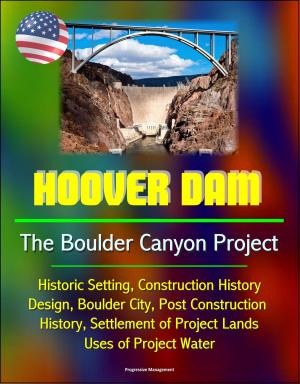Aerospace Power in the Twenty-First Century: A Basic Primer - Air and Space Power, Doctrine and Strategy, Airpower, Satellites, Billy Mitchell, Claire Chennault, Reconnaissance
Nonfiction, Science & Nature, Technology, Aeronautics & Astronautics, History, Military, Aviation| Author: | Progressive Management | ISBN: | 9781476240084 |
| Publisher: | Progressive Management | Publication: | March 22, 2012 |
| Imprint: | Smashwords Edition | Language: | English |
| Author: | Progressive Management |
| ISBN: | 9781476240084 |
| Publisher: | Progressive Management |
| Publication: | March 22, 2012 |
| Imprint: | Smashwords Edition |
| Language: | English |
From the Foreword: Dr. Chun's Aerospace Power in the Twenty-First Century: A Basic Primer is a great start towards understanding the importance of aerospace power and its ability to conduct modern warfare. Aerospace power is continually changing because of new technology, threats, and air and space theories. However, many basic principles about aerospace power have stood the test of time and warfare. This book provides the reader with many of these time-tested ideas for consideration and reflection. Although Aerospace Power in the Twenty-First Century was written for future officers, individuals desiring a broad overview of aerospace power are invited to read, share, and discuss many of the ideas and thoughts presented here. Officers from other services will find that this introduction to air and space forces will give them a good grasp of aerospace power. More experienced aerospace leaders can use this book to revisit many of the issues that have affected air and space forces in the past and that might affect them in the future. Air Force officers will discover that Aerospace Power in the Twenty-First Century is a very timely and reflective resource for their professional libraries.
Addressed either to the novice or any individual who wants to understand the rudimentary aspects of aerospace power, this book exposes readers to relevant aerospace capabilities, theories, applications, operational planning, and key issues. Theories and applications of aerospace power are not limited to the United States Air Force but apply to aerospace forces in general. Although the Air Force has forces and capabilities that include a very wide range of activities, other air and space forces reflect several of these same capabilities and many unique ones. Understanding how these forces operate can help both students who are new to aerospace power and individuals familiar with ground and maritime forces appreciate the strengths and weaknesses of air and space forces.
The book introduces the reader to definitions and concepts of aerospace power. Material in chapter 1 provides a set of definitions, characteristics, and concepts for readers. Aerospace power is defined in terms of how it contributes to the successful conduct of war through an evaluation of its ability to operate under a set of principles of war. A discussion of the environment and elements of aerospace power concludes the chapter.
Chapter 2 gives the reader a survey of major air and space theories. A study of any academic subject calls for a good theoretical foundation to explain and predict actions. Diverse theories address the application of aerospace power. Some of them view airpower as a force that can replace other military capabilities. Some stress the integration of airpower into existing forces, while others maintain that air and space assets should provide greater support to other forces. Several theories were written just after the introduction of the airplane. Others are more contemporary views that look at airpower and space power through the prism of experience gained from conflicts and advancements in capabilities that illustrate the value of air and space systems.
Contents: Chapter 1 - Aerospace Concepts and Definitions * Chapter 2 - Aerospace Power Theory * Chapter 3 - Functions and Capabilities of Aerospace Power: Air and Space Superiority / Strategic Attack * Chapter 4 - Functions and Capabilities of Aerospace Power: Interdiction / Close Air Support, Interdiction: Striking the Enemy Before He Can Attack * Chapter 5 - Functions and Capabilities of Aerospace Power: Rapid Mobility/Space and Information, Mobility Operations: Moving Manpower, Munitions, and Machines * Chapter 6 - Functions and Capabilities of Aerospace Power: Airpower Unleashed * Chapter 7 - Planning for Aerospace Operations * Chapter 8 - Taking Off into the Wild Blue Yonder
From the Foreword: Dr. Chun's Aerospace Power in the Twenty-First Century: A Basic Primer is a great start towards understanding the importance of aerospace power and its ability to conduct modern warfare. Aerospace power is continually changing because of new technology, threats, and air and space theories. However, many basic principles about aerospace power have stood the test of time and warfare. This book provides the reader with many of these time-tested ideas for consideration and reflection. Although Aerospace Power in the Twenty-First Century was written for future officers, individuals desiring a broad overview of aerospace power are invited to read, share, and discuss many of the ideas and thoughts presented here. Officers from other services will find that this introduction to air and space forces will give them a good grasp of aerospace power. More experienced aerospace leaders can use this book to revisit many of the issues that have affected air and space forces in the past and that might affect them in the future. Air Force officers will discover that Aerospace Power in the Twenty-First Century is a very timely and reflective resource for their professional libraries.
Addressed either to the novice or any individual who wants to understand the rudimentary aspects of aerospace power, this book exposes readers to relevant aerospace capabilities, theories, applications, operational planning, and key issues. Theories and applications of aerospace power are not limited to the United States Air Force but apply to aerospace forces in general. Although the Air Force has forces and capabilities that include a very wide range of activities, other air and space forces reflect several of these same capabilities and many unique ones. Understanding how these forces operate can help both students who are new to aerospace power and individuals familiar with ground and maritime forces appreciate the strengths and weaknesses of air and space forces.
The book introduces the reader to definitions and concepts of aerospace power. Material in chapter 1 provides a set of definitions, characteristics, and concepts for readers. Aerospace power is defined in terms of how it contributes to the successful conduct of war through an evaluation of its ability to operate under a set of principles of war. A discussion of the environment and elements of aerospace power concludes the chapter.
Chapter 2 gives the reader a survey of major air and space theories. A study of any academic subject calls for a good theoretical foundation to explain and predict actions. Diverse theories address the application of aerospace power. Some of them view airpower as a force that can replace other military capabilities. Some stress the integration of airpower into existing forces, while others maintain that air and space assets should provide greater support to other forces. Several theories were written just after the introduction of the airplane. Others are more contemporary views that look at airpower and space power through the prism of experience gained from conflicts and advancements in capabilities that illustrate the value of air and space systems.
Contents: Chapter 1 - Aerospace Concepts and Definitions * Chapter 2 - Aerospace Power Theory * Chapter 3 - Functions and Capabilities of Aerospace Power: Air and Space Superiority / Strategic Attack * Chapter 4 - Functions and Capabilities of Aerospace Power: Interdiction / Close Air Support, Interdiction: Striking the Enemy Before He Can Attack * Chapter 5 - Functions and Capabilities of Aerospace Power: Rapid Mobility/Space and Information, Mobility Operations: Moving Manpower, Munitions, and Machines * Chapter 6 - Functions and Capabilities of Aerospace Power: Airpower Unleashed * Chapter 7 - Planning for Aerospace Operations * Chapter 8 - Taking Off into the Wild Blue Yonder















